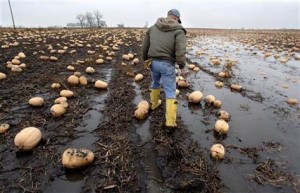This is not a post about Pumpkin Spice Latte.
 If I were to judge by one of the predominant memes on social media, one might think that the main food-related conversation around the arrival of the fall season is that spicy, syrupy, coffee-ish beverage at your corner Starbucks. I’m not personally a fan of the drink, but thinking about that omnipresent concoction of cinnamon and cloves was a jumping-off point for my musings on this first Friday of autumn.
If I were to judge by one of the predominant memes on social media, one might think that the main food-related conversation around the arrival of the fall season is that spicy, syrupy, coffee-ish beverage at your corner Starbucks. I’m not personally a fan of the drink, but thinking about that omnipresent concoction of cinnamon and cloves was a jumping-off point for my musings on this first Friday of autumn.
Pumpkin – or at least the sensory experience that we associate with “pumpkin” – is such a psychological marker of this time of year. Retailers leverage that fact with orange merchandise displays to give us visual cues, and food companies leverage it with the release of limited-time products such as Oreos to fill our mouths and social lives with pumpkin-y warmth. More than just utilizing a seasonal fruit (it’s botanically a BERRY – who knew?), the product development and marketing efforts are very probably meant to evoke a connection to cozy memories of family, friends, comfort and love. According to food historians, pumpkin pie is truly one of the most authentic American desserts. With some additional thanks to simple back-of-the-can recipes, generations of families have made pie and other pumpkin treats a memorable staple of their fall menus.
But what happens when something so loved, so desired and so demanded … is in danger of not being available?
That was indeed the case in October 2009 when the holiday season approached and Americans were dismayed to learn that their favorite canned pie filling was in short supply due to wet conditions during the previous year’s pumpkin growing season. Fortunately the scare was short-lived as the current crop was harvested, processed and rushed to grocery stores, but it was definitely a moment to think: what would we do without a gotta-have product?

As many Southern cooks will attest, you can make a very good “pumpkin” pie with sweet potatoes. Other foods that we have grown to love with a special intensity aren’t quite so lucky to have an indistinguishable proxy available in times of crisis. Take avocados. Over the last decade or so, we Americans have more than doubled the amount of avocados that we eat per person annually, and despite the fruit’s diverse means of usage, we still eat a ton of it in the form of guacamole. For a short while this past spring, the nation was abuzz about the possibility that there might be a shortage of the green goodness after Mexican fast-food chain Chipotle mentioned in its annual report that guacamole could possibly be dropped from its menu if avocado supplies faltered due to changing global weather patterns. The mere suggestion that such a thing *could* happen spawned national media coverage and social media chatter around “Guacapocalypse.” We saw some resourceful bloggers offer up recipes for “guacamole” made with other mashed produce ranging from peas and edamame to broccoli and asparagus. In reality, avocados are a plentiful year-round crop supplied by numerous growing regions, and there was no shortage.
Spicy food lovers recently were alarmed at the prospect of a shortfall of the cult-favorite condiment Sriracha when the bottler was nearly forced to cease or relocate its operations. Today I read about the need for sourcing more hazelnuts to feed our insatiable, growing appetite for Nutella spread. All of this points to the fact that our global food supply and savvy marketing have created an expectation of product availability from consumers that borders on fanatical. Our cautionary lesson is to manage not only inventory, but consumer expectations.
For more information about our Food, Beverage and Nutrition practice, click here.
